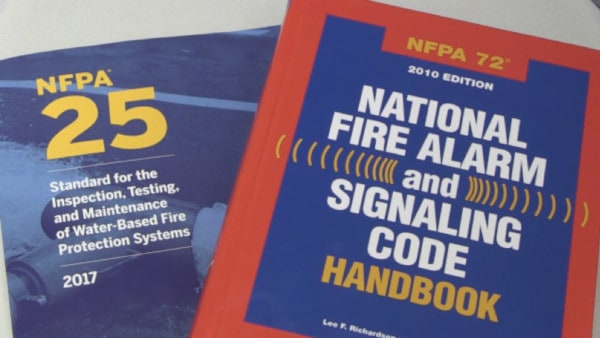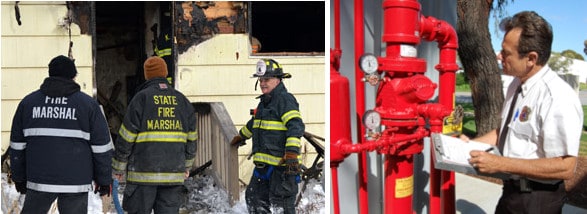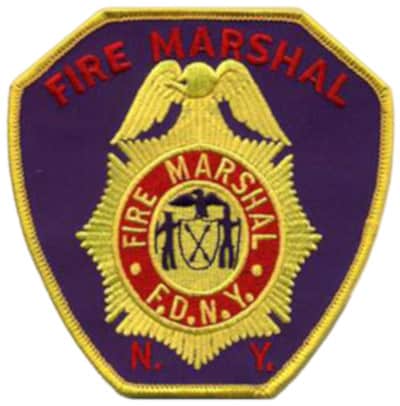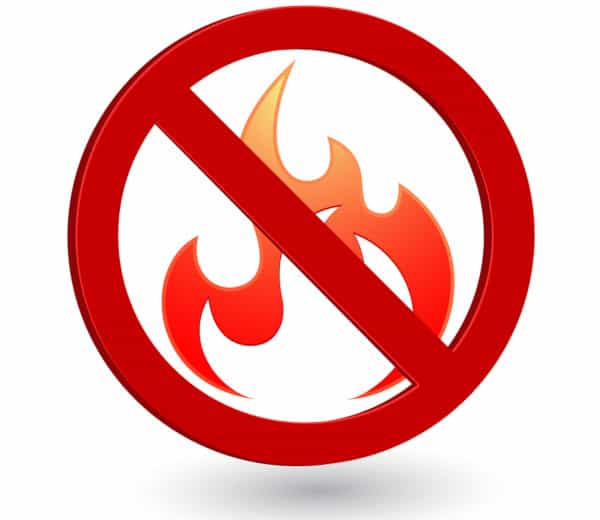The differing roles and jurisdictions of a fire marshal, and how they fit into the AHJ puzzle
Authorities having jurisdiction (AHJ) are a big deal in fire protection. They feature heavily in the standards and codes of the National Fire Protection Association (NFPA) as the ultimate arbiter of what will or won’t work in terms of a structure’s fire protection measures. But what is an AHJ? And what is a fire marshal—and are they always the AHJ?
Basically, whatever you do in fire protection, it must stand up to the scrutiny of an AHJ. If you want to hire a qualified fire protection contractor, you must make sure they are licensed by the state or otherwise considered qualified by the relevant AHJ. If you want to perform fire sprinkler head replacement, you or other personnel must be authorized by the AHJ. And many exceptions to the rules in NFPA standards are only applicable if the AHJ approves them. The list goes on.
But many people aren’t sure what an AHJ is, or who exactly qualifies as one in their area. Often, they have an assumption—often correct—that it’s simply the state or local fire marshal.
Not all AHJs are fire officials, but all have a stake in a building’s safety
In the context of fire protection, an AHJ basically enforces regulations. The 2018 edition of NFPA 101: Life Safety Code partially explains their role:
4.6.1.1 The authority having jurisdiction shall determine whether the provisions of this Code are met.
4.6.1.2 Any requirements that are essential for the safety of building occupants and that are not specifically provided for by this Code shall be determined by the authority having jurisdiction.
4.6.1.3 Where it is evident that a reasonable degree of safety is provided, any requirement shall be permitted to be modified if, in the judgment of the authority having jurisdiction, its application would be hazardous under normal occupancy conditions.
In other words, the AHJ inspects facilities to determine if the text of NFPA 101 and various other model codes and standards and laws have been implemented properly. The AHJ can enforce or impose additional requirements beyond those stipulated in given fire code, and may otherwise modify them according to their judgment or local mandates.
Many different people and organizations can be AHJs, and your facility may also be subject to the authority of multiple AHJs. Annex A of NFPA 72: National Fire Alarm and Signaling Code (2019 edition), for example, says:
A.3.2.2 The phrase “authority having jurisdiction,” or its acronym AHJ, is used in NFPA documents in a broad manner, since jurisdictions and approval agencies vary, as do their responsibilities.
At times, the term encompasses insurers, building inspectors, and nearly any entity involved in ensuring that a structure’s design and construction meet binding safety provisions.
Regardless of the AHJ type, the letter of the law dominates
This previous section of NFPA 72 goes on to list many possible AHJs in the public and private sectors. We can break out this long list into two groups: those who have authority because of a contract and those who have authority because of the law.
Contractual AHJs can include groups such as insurance companies and property owners. Property owners can set individually desired fire protection standards for their property. Similarly, insurance companies can change premiums based on fire protection measures. However, insurance companies, property owners, and other private authorities must follow the law. Their requirements can exceed legal requirements, but they cannot undercut the law.
The only AHJs with the force of law behind them are government entities. State and local governments write or adopt model fire code from NFPA and the International Code Council (ICC) into laws, sometimes with exclusions or additions. AHJs acting as their representatives inspect facilities, impose fines, order fire watches, license contractors, investigate the cause of fires, and more.

For new fire protection systems, for example, the authority having jurisdiction for the building and fire codes is the agency that issues the construction permit. In many cases, it is the building department and in some, the fire department. And even more instances have the building department as the permitting agency, but they simply get the fire department involved internally.
Common AHJs include labor departments, health departments, and building officials. And, of course, one of the most common and important government AHJs is the fire marshal.
What is a fire marshal?
“Marshal” conjures up images of the Wild West. The word is an old one, originally meaning something like “groom” (someone who tends horses for a household). Its Old High German (spoken as early as 750 AD) precursor “marahscalc” is a compound of words meaning “horse” and “servant.”
Over the years, the term’s meaning drifted away from maintaining order in the stables to maintaining order elsewhere, such as in the military or in ceremonies like parades. In the United States, the title has lost its military meaning but has remained connected to order. George Washington and the First Congress created U.S. Marshal Service in 1789. Nowadays, the U.S. Marshals hunt fugitives and hide witnesses. And over time, the word’s theme of maintaining public order naturally made its way into fire protection.
Fire marshals enforce fire code plus carry out other fire protection duties. Their specific responsibilities and powers vary from place to place but we can generalize. While NFPA does not publish exact standards that define a fire marshal (that would be out of their scope), they do operate the International Fire Marshal’s Association. Full membership in this professional organization is open to lawfully appointed fire officials. Fire marshals, according to the IFMA, are charged by law with duties in at least one of these areas:
- Building inspection
- Enforcement of fire code
- Public education
- Investigation of the cause and origin of fires
Not everyone who performs these duties carries the title “fire marshal.” They may instead work under the fire marshal, who is often a high-ranking official overseeing a staff of inspectors and investigators.

QRFS asked Captain Earl Dyer Jr., Interim Fire Marshal at the Richmond Fire Department, what his job is all about. He summed it up in this way:
“The overall duty of the Fire Marshal’s Office is to create a safe environment for those that are citizens here, for those that visit, and even those that are passing through … This office does more than just looking at ways to prevent fires, we are involved in many other tasks; inspection of child safety seats, safety talks, community events, fire extinguisher training, etc. Our overall mission is the preservation of life and property.”
To this end, he and those under his command spend their days answering complaints, conducting inspections, training with the fire department, witnessing fire evacuation drills, and addressing environmental hazards.
When it comes to code enforcement, Captain Dyer says that his office prefers teaching to citations. “The process for my staff here is: be educators first.” If education does not achieve compliance, his office issues Notices of Violation. Such notices are the first step on a path that can end in court.
Captain Dyer emphasized the lifesaving mission of his office: “It truly is about life safety and being able to go to bed at night knowing that you have done your very best to ensure those you have charged with keeping safe, they too have a restful night.”

Jurisdiction: where do fire marshals work?
Fire Marshals can work for cities, counties, or states. While they all have similar mandates—fire prevention, code enforcement, and investigation—their roles can vary in different jurisdictions.
City fire marshals
Cities commonly employ fire marshals and, at this level of government, the office of the fire marshal usually exists within the fire department. In Dallas, TX, for instance, the city’s fire marshal is also a deputy fire chief in the Dallas Fire-Rescue Department.
The fire marshal’s office may review plans or inspect construction sites when anyone acquires city building permits. However, again, other city inspectors may perform these reviews and inspections as well. City fire marshals likely inspect and issue various permits for businesses, especially those performing hazardous work.
When a fire does happen, it often falls to the city fire marshal and their investigators to determine the cause and source. This may include apprehending arsonists in some municipalities, and some have dedicated arson investigators under the fire marshal’s command. Such investigators may be sworn law enforcement officers for the city. In New York City, for example, only fire marshals investigate arson. They are sworn, weapons-carrying law enforcement officers. This is not the norm, though.
County fire marshals
Counties may also employ fire marshals. But what’s the point of a county fire marshal if cities have their own?
Think of it this way: If you live in an incorporated town or city, you likely have a municipal police department with a police chief somewhere beneath the mayor in the chain of command. But you probably also have a sheriff’s office serving the county. The sheriff is there to serve people in unincorporated areas and in municipalities too small to have their own law enforcement, and to fulfill special mandates such as operating jails and serving warrants.
In a similar way, you might deal with county fire marshals if you live or work in an unincorporated area or a municipality otherwise served only by a county fire department. And depending on how the county government works, counties can also have their own fire code.
State fire marshals
Many states have them and just like state police play a special role, state fire marshals have special tasks. You usually see state troopers on the highway between cities, at state buildings, and maybe at the DMV when you take your driving test (recall: a driver’s license is a state license).
State fire marshals are similar—they serve areas that otherwise would not have a fire code-enforcement or fire-investigation official and have jurisdiction over state buildings as well as facilities that receive permits from the state. For instance, Virginia State Fire Marshals inspect schools, nightclubs, and health care facilities. Missouri State Fire Marshals inspect assisted living centers, residential care facilities, daycare facilities, and mental health facilities (among others).
Keep in mind that, just like local police can and do enforce state and federal laws, local fire marshals may enforce state fire code. The Richmond Fire Marshal’s Office enforces statewide code, for instance.
Fire Marshals—common AHJs in charge of fire protection
In most areas, the fire marshal is the premier authority on fire protection. It’s their job to make sure people are adequately prepared for a fire by inspecting facilities and enforcing laws. When a fire does occur, they investigate and determine what happened. And if you operate some kind of business, you can expect to deal with a fire marshal and perhaps other fire protection AHJs.
QRFS can help you keep code-enforcement officials happy by outfitting you with fire extinguishers, fire sprinklers, signs and decals, standpipe hardware, and many other fire protection system needs.
Can’t find what you need on our website? Contact us at +1 (888) 361-6662 or support@qrfs.com and we’ll help you get it.
This blog was originally posted at blog.qrfs.com. If you enjoy our content, check us out at Facebook.com/QuickResponseFireSupply or on Twitter @QuickResponseFS.



